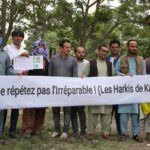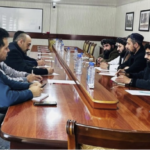The rapid US withdrawal from Afghanistan is putting intense pressure on the CIA to find new ways to gather intelligence and conduct counter-terrorist attacks in the country, but the agency has few good options.
The CIA, which has been at the center of a 20-year US presence in Afghanistan, will soon lose its bases in the country from which it has conducted combat missions and drone strikes, closely monitoring other groups such as the Taliban and al Qaeda. Islamic State. Agency analysts are warning of ever-increasing risks of a Taliban takeover.
United States officials are making last-minute efforts to secure bases close to Afghanistan for future operations. But the complexity of the ongoing conflict has led to thorny diplomatic talks, according to US officials and regional experts, as the military pulled out all forces by mid-July, long before President Biden’s September 11 deadline.
One focus has been Pakistan. The CIA used a base there for years to launch drone strikes against terrorists in the country’s western mountains, but was forced out of the facility in 2011, when US ties with Pakistan were exposed.
Any deal now has to work around the uncomfortable reality that the government of Pakistan has long been backing the Taliban. In discussions between US and Pakistani officials, Pakistanis have demanded a variety of sanctions in exchange for the use of a base in the country, and effectively required them to sign off on any target the CIA or military would like. According to three Americans familiar with the discussion, struck inside Afghanistan.
Diplomats are also exploring the option of gaining access to bases in former Soviet republics that were used for the Afghanistan war, although they expect Russian President Vladimir V. Putin to strongly oppose it.
Recent CIA and military intelligence reports on Afghanistan have been increasingly pessimistic. He has highlighted gains by the Taliban and other terrorist groups in the south and east, and warned that Kabul could fall into Taliban hands within years and become a safe haven for terrorists intent on attacking the West, As estimation according to many familiar people.
As a result, US officials see a need to gather intelligence over longer periods of time – in addition to military and CIA counter-terrorism operations in Afghanistan – after the deadline Mr Biden set for troops to leave the country. But the scramble for bases shows that US officials still lack a long-term plan to address security in a country where they have spent trillions of dollars over nearly two decades and lost more than 2,400 soldiers. Have given.
CIA Director William J. Burns has accepted the challenge facing the agency. “When the time comes for the US military to withdraw, the US government’s ability to collect threats and act will diminish,” he told senators in April. “It’s just a fact.”
Mr Burns made an unannounced visit to Islamabad, Pakistan in recent weeks to meet with the head of the Pakistani military and the head of the Directorate of Inter-Services Intelligence, the country’s military intelligence agency. According to US officials familiar with the talks, Defense Secretary Lloyd J. Austin III has had frequent phone calls with the Pakistani military chief about seeking the country’s help for future US operations in Afghanistan.
According to people briefed about the meeting, Mr. Burns did not raise the issue of Aadhaar during his visit to Pakistan; The visit focused on comprehensive counter-terrorism cooperation between the two countries. At least some of Mr Austin’s discussions have been more direct, according to people who have been privy to him.
Two decades of war in Afghanistan has helped turn the spy agency into a paramilitary organization: It conducts hundreds of drone strikes in Afghanistan and Pakistan, trains Afghan commando units and a string of CIA officers in a string of bases on the border. Has a great presence. Pakistan. At one point during President Barack Obama’s first term, the agency had several hundred officers in Afghanistan, the largest increase of personnel in a country since the Vietnam War.
These operations have come at a cost. The nightly raids by CIA-trained Afghan units left a trail of abuse that increased support for the Taliban in parts of the country. Sometimes misguided drone strikes in Pakistan have killed civilians and increased pressure on the government in Islamabad to withdraw its quiet support for the CIA’s operations.
Douglas London, the former head of CIA counter-terrorist operations for Afghanistan and Pakistan, said the agency is likely to rely on a “staying behind” network of informers in Afghanistan who will gather intelligence on the stability of the Taliban, al Qaeda, the central government and the United States. Government and other subjects. But without a large CIA presence in the country, he said, conducting intelligence investigations would be a challenge.
In the short term, the Pentagon is using an aircraft carrier to launch fighter jets into Afghanistan to support the troop withdrawal. But the carrier’s presence is unlikely to be a long-term solution, and military officials said it likely won’t be redeployed long after the last US military departure.













